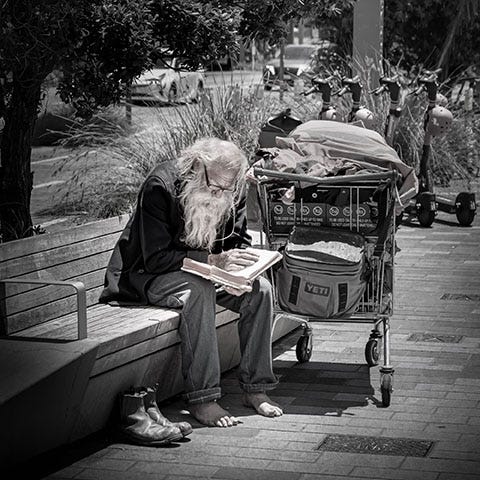postscript - entry 345
A few observations I offered here as a postscript to entry 345 of my NZ Visual Diary photography blog.
I carry a camera with me at all times when I am out and about for more than the obvious reason, that is to take photographs. Having a camera in my hand anchors me in the moment. It is my way of fighting mental drift (in an age of attention disorder) by fixating my concentration on the task of relentless focus, especially on the essential substrates of photography (light & shadow or colour; shape and pattern; visual metaphor & message; etc.).
Therefore, I can state with considerable confidence that rarely does one sight an elderly man, who appears to be a rough sleeper, engaged in the public act of reading a book. It was for me so much more than a rare photographic opportunity.
And while I am comfortable having limited my commentary in entry 345 to two phrases in praise of absorbed reading, there is a need for much more to be said about the likely circumstances of the reader pictured.
My time as a permanent resident in New Zealand (6+ years) could be characterised by the haunting opening line of the Charles Dickens’ novel A Tale of Two Cities: "It was the best of times, it was the worst of times.” There is so much to admire about New Zealand - the land, the people, the quirky take on British culture and sensibility and so much more. I could wax endlessly about how much I enjoy living in New Zealand, indeed of being a Kiwi.
And yet, New Zealand over the past forty years has transformed in ways that belie its image held by an outside world as a land of milk and honey, that paradise at one remote corner of the world.
Because of its peculiar political economy — that has wealth disproportionately (almost exclusively) defined by holdings in land and property — New Zealand has experienced over the past forty years the highest rate of accelerating wealth inequality of any OECD country. The consequences of increasing wealth inequality are acutely expressed by its housing crisis.
For the 60% of Kiwis, and notably older Kiwis, who own a home life is pretty sweet. Not so much for the 40% who rent, especially for the working poor and retiree who spend on average more than fifty percent of their post-tax income on housing in the form of rents. That rate of rent payment can be as high as 70% of their weekly incomes.
It is therefore shocking but perhaps not surprising that, among the developed economies of the world, New Zealand has the second highest rate of homelessness as a proportion of total population. Great Britain tops the chart and its unenviable place on the homelessness index may also be explained by its peculiar history of land ownership and wealth.
With an economy anchored by a ‘monoculture’ wealth index of land & property, combined with an anaemic stock of affordable housing for long-term rent or purchase, New Zealand has experienced over the past forty years some of the worst shocks and consequences of the neoliberal turn in world political economies. Gone are the days of stable state housing programmes, ensuring that Kiwis had a roof (perhaps a leaky roof) over their heads.
Finally, in no segment of New Zealand’s total population is housing insecurity more acutely felt than among its young (under 25 years old), which by estimates accounts for half of New Zealand’s homeless population.
A tale of two countries within one.

